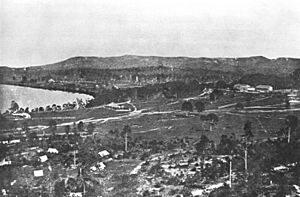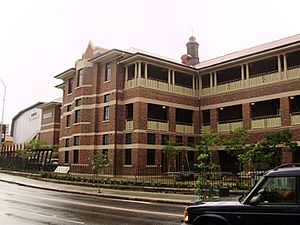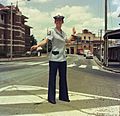Petrie Terrace Police Depot facts for kids
Quick facts for kids Petrie Terrace Police Depot |
|
|---|---|

Entrance to the former Petrie Terrace Police Depot, 2009
|
|
| Location | 25-61 Petrie Terrace, Petrie Terrace, City of Brisbane, Queensland, Australia |
| Design period | 1840s–1860s (mid-19th century) |
| Built | 1850s–1960s |
| Official name: Petrie Terrace Police Depot (former), Underground Night Club | |
| Type | state heritage (built, archaeological) |
| Designated | 23 July 1999 |
| Reference no. | 601894 |
| Significant period | 1850s-1860s, 1930s (historical) 1850s-1930s (fabric) |
| Significant components | parade ground/quadrangle/assembly ground, barracks – police, stables, roof/ridge ventilator/s / fleche/s, garage, fence/wall – perimeter, wall/s – retaining, workshop |
| Builders | Andrew Petrie, John Petrie, Joshua Jeays |
| Lua error in Module:Location_map at line 420: attempt to index field 'wikibase' (a nil value). | |
The Petrie Terrace Police Depot is a special place in Petrie Terrace, Brisbane, Queensland, Australia. It used to be a police barracks, which is a building where police officers live and train. This historic site was built over many years, from the 1850s to the 1960s. It was added to the Queensland Heritage Register on 23 July 1999 because of its important history.
The police left the site in the mid-1980s. It was then sold in 1987. The main police barracks building was empty for about 20 years. Other buildings on the site were used for different things. In 2007–2008, the whole area was rebuilt. It became a shopping and business area called "The Barracks."
Contents
A Look Back: History of the Police Depot
The Petrie Terrace Police Depot is on a hill called Green Hills. It looks over the old Roma Street railway yards and the centre of Brisbane. This spot has been used for prisons and police work in Queensland since the 1850s.
Early Days: The Brisbane Gaol
From November 1860 to July 1883, this site was home to the second Brisbane Gaol (prison). After that, it became a police barracks from 1885 until the mid-1980s. The main Police Barracks building, which opened in 1939, is a well-known landmark in Brisbane.
When the Moreton Bay area was opened for free settlers in 1842, there wasn't much prison space. A temporary prison was set up in 1847. Brisbane's first purpose-built prison was finished in 1849. But soon, a bigger prison was needed.
By 1856, a new prison area was planned near what is now Petrie Terrace. This area was called Green Hills. It was chosen because it was far away from the town, had good drainage, and was healthy. In 1857, plans for a prison for almost 100 people were made. The building work started in 1858. Andrew Petrie and John Petrie, whose family name is now part of Petrie Terrace, built it.
The prison was finished in September 1860. It had two-storey cell blocks and guard houses. There was also a kitchen, washhouses, and toilets. A wooden fence surrounded the prison at first. In 1862, a tall stone wall was built by Joshua Jeays. The stone came from the Woogaroo Quarry.
Overcrowding and New Prisons
The Brisbane Gaol on Petrie Terrace quickly became too crowded. By 1865, extra prisoners were kept on a ship called the Proserpine. In 1867, a prison was set up on St Helena Island in Moreton Bay. This helped, but the Brisbane Gaol was still too full.
In the late 1870s, plans for a new prison, the Boggo Road Gaol, were made. This new prison was built in the early 1880s. The Petrie Terrace Gaol closed on 2 July 1883.
From Prison to Police Depot
After the prison closed, the government thought about using the site for the Queensland Defence Force. But in 1885, the old prison land was split. Part of it went to the Defence Force, and the rest became the Queensland Police Force's depot and training centre.
The police used the old guard houses and other buildings as offices and living quarters. The old cell blocks were pulled down. The police stayed at this site for 100 years, from 1885 until the mid-1980s.
The tall stone wall around the old prison was mostly removed in 1885. Some of the stone was reused in other Brisbane projects. The stone base of the fence along Petrie Terrace today is believed to be from this old prison wall.
Growing Police Force and New Buildings
In the 1880s, Queensland's economy grew, and more police officers were needed. Recruits trained at the Petrie Terrace Police Depot. But the living conditions were not good. The barracks were damp and crowded.
Despite the poor conditions, only small changes were made before 1901. From 1895 to 1925, Queensland's population almost doubled. The police force also grew. Many new buildings were added to the Petrie Terrace Police Depot in the early 1900s:
- A washhouse (1901, now gone).
- A house for the Police Drill Instructor (1907, now gone).
- A two-storey dormitory building (1907, now gone).
- A brick stables building for horses (1912, still here).
- Big additions to an old dormitory building (1914–1915, now gone).
The 1912 brick stables could hold 40 horses. As cars became more common for police work, parts of the stables were changed into garages in 1927. A large brick garage and workshop was built in 1936.
The New Police Barracks
By the late 1930s, the police needed better buildings. In 1938, work began on a new three-storey brick and concrete police barracks at Petrie Terrace. This building was meant for new recruits and single officers. At that time, single officers had to live in the barracks.
The new barracks was designed to be comfortable and look impressive. It was built on a hill, so it stood out. The ground floor had offices, a store, an armoury, a guard room, and a lecture theatre. It also had a kitchen and dining area. The second and third floors had bedrooms, bathrooms, and recreation rooms for 100 officers.
The building was made with fireproof materials like brick and cement. It had verandahs and balconies on each floor to help with the warm Brisbane weather. Escape stairs were also included for safety.
When the barracks opened on 29 September 1939, it was seen as a great investment. It was thought to improve the police force's reputation. The building was praised for its modern look and strong design. It became a well-known landmark.
Raymond Clare Nowland, an architect from the Department of Public Works, designed the new barracks. He designed many important buildings in Queensland during the 1930s.
Changes During and After World War II
The new barracks was the first step in a bigger plan to update the whole police depot. In the early 1940s, the old Brisbane Gaol buildings were pulled down. The area was levelled to create a parade ground.
In 1941, a brick building for the Police Wireless Transmission Station VKR was built. This station helped police communicate with patrol cars using two-way radio. It also linked to other police wireless services across Australia. This new technology changed police work.
During World War II, military police from different countries also used the wireless station. An observation post was set up at the depot in 1942. The 1912 stables were fully converted into a garage during the war.
After the war, the police continued to improve their radio communication. In the late 1940s, a tall aerial pole was put up to help with interstate police wireless services.
By 1945, the depot was struggling to house all the new cadets and officers. In 1949–1950, the 1907 barracks building was updated.
Modernisation and New Uses
Many changes were made to the Petrie Terrace Depot in the 1950s. These changes reflected new technologies and policing methods.
In 1951, Brisbane's Central Communications Room opened. It took over handling police radio from the VKR station at Petrie Terrace. In 1953, two tennis courts were removed to build a large garage for 30 vehicles.
In 1956, parts of the 1938–1939 police barracks were changed into offices for the Police Commissioner. Single officers no longer lived at the depot. Also, old buildings were removed to create a large parade ground.
In the early 1960s, many police offices moved to a new building at North Quay. The 1938–1939 building at Petrie Terrace was changed back into barracks for new officers. The 1907 barracks building was removed.
The Petrie Terrace Police Depot stopped being a training centre in 1973. This function moved to the Oxley Police Academy. However, the depot continued to be used by the police until the mid-1980s.
In 1987, the government sold the old police site to a private company. The former Police Stables became the Underground Nightclub. The old Police Wireless Transmission Station became a restaurant. The main Police Barracks building was empty for a long time and was damaged. The open area, which used to be the old prison site, became a carpark.
In 2007–2008, the entire Police Depot area was renovated. The three remaining buildings (barracks, stables, and wireless station) were updated. The site is now a retail and business area called "The Barracks." It has a supermarket, restaurants, shops, and cinemas.
What's There Now: Important Buildings
The former Petrie Terrace Police Depot is on the edge of a hill. It looks out over the old Roma Street railway yards and Brisbane city centre. It is bordered by the railway, Upper Roma Street, Petrie Terrace, and the Victoria Barracks military area. Several important parts of the site are still there:
The Former Police Barracks
The old police barracks building, opened in 1939, is very easy to see from many parts of Brisbane. It stands out on the hill overlooking the city. It's a three-storey building made of red brick and concrete. It has a roof with corrugated fibro cement tiles.
The front of the building is symmetrical. It has a central entrance with stairs leading to a covered porch. Verandahs are on each side of the central part on every floor. The building's design looks strong and impressive. It has decorative terracotta tiles and arrow patterns around the doors.
Inside, the building has a central staircase with terrazzo steps. The stairs have a wooden handrail and decorative metal balustrading. The walls are brick, and the floors are concrete. The layout of the rooms, including bedrooms, lecture theatre, and recreation rooms, is still mostly the same.
The Former Stables
The old stables building is on the side of the site facing Caxton Street. It's a single-storey brick building with a red metal roof.
This building was partly changed into a garage in the 1920s and fully in the 1940s. More recently, it was turned into a nightclub. The inside has been changed a lot with new floors and walls.
However, many original parts of the building are still there. These include most of the brick outer walls. You can still see where windows were bricked up, showing where horse stalls used to be. The strong timber roof structure and large timber vents are also still in place.
The Former Garage and Workshop
The old garage and workshop was built next to the stables in 1936. It's a single-storey brick building with a red metal roof. It has also been changed to be part of the nightclub. The floor and ceiling have been redone. Some windows were turned into doors. But the main walls and some inner walls are still original.
The Former Police Wireless Transmission Station (VKR)
The old police wireless transmission station is a brick building near Petrie Terrace and Milton Road. It now houses a restaurant. The inside and much of the outside have been changed a lot. This building is not part of the official heritage listing for the Petrie Terrace Police Depot.
Other Important Site Features
A wrought iron fence with a stone base runs along the Petrie Terrace boundary. You can still see a gate post from the old vehicle entrance. There is also a stone retaining wall between the old police and military areas. The open area to the southeast is now a carpark. It contains important historical remains from the old Brisbane Gaol underground.
Why It's Important: Heritage Listing
The former Petrie Terrace Police Depot was added to the Queensland Heritage Register on 23 July 1999. This means it's a very important historical site for Queensland.
It shows how Queensland's history has changed. The site has a long history with prisons and police work in Brisbane. It's part of a group of old prison, military, and police buildings from the 1860s.
Important parts of the site include:
- Underground remains of the old Brisbane Gaol (1860–1883): These are very important for understanding the history of prisons in colonial Queensland.
- The stone retaining wall: This wall between the police and military areas is beautiful because of its natural stone. It's also important because it's made from stone from the old Brisbane Gaol wall.
- The wrought iron and stone fence along Petrie Terrace: This fence is also made from stone from the old prison wall. It adds to the look of Petrie Terrace street.
- The 1912 police stables: Even though it's been changed, it still shows what stables were like. It's important for understanding how police worked with horses before cars.
- The 1936 police garage and workshop: This building shows how police work changed when cars became common in the 1930s.
It's a rare example of its kind. The 1938–1939 police barracks is a rare example of a place built for unmarried police officers to live in the early 20th century.
It can teach us more about Queensland's history. Because it was the site of the second Brisbane Gaol, there might be archaeological findings underground. These could help us learn more about prisons and punishment in early Queensland. The open area was where many prison buildings and yards were. It was also used as a parade ground and for other police activities.
It shows the main features of police training and administration. The former Police Stables, Garage and Workshop, Police Barracks, and Wireless Transmission Station, along with the fences and walls, form a group of buildings. They help us understand how police were trained and managed in Queensland in the first half of the 20th century.
It has great aesthetic value (it looks good!). The buildings and structures at the depot have a special look. They add to the streetscape of Petrie Terrace. The stone walls and fences have a rustic, natural beauty.
The 1938–1939 police barracks looks lively and strong with its red brick and concrete patterns. It has decorative terracotta tiles and arrow designs. It's a prominent landmark that can be seen from many parts of Brisbane.
It has a special connection to the community. The underground remains of the old Brisbane Gaol are important for their historical and social meaning.
It's linked to important people and groups in Queensland's history. The Petrie Terrace Police Depot is important because of its long connection with the Queensland Police Force. It shows how police work and life changed over time in a big city.
The 1938–1939 police barracks was the only building completed from a big plan for new police buildings in Brisbane in the 1930s. It's also important because of the work of the Department of Public Works and the architect Raymond Clare Nowland. It's one of his most famous designs.
Images for kids






